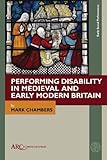Performing Disability in Medieval and Early Modern Britain / Mark C. Chambers.
Material type: TextSeries: Early Social PerformancePublisher: Leeds : ARC Humanities Press, [2024]Copyright date: 2024Description: 1 online resource (200 p.)Content type:
TextSeries: Early Social PerformancePublisher: Leeds : ARC Humanities Press, [2024]Copyright date: 2024Description: 1 online resource (200 p.)Content type: - 9781802701944
- 822.3099207
- online - DeGruyter
| Item type | Current library | Call number | URL | Status | Notes | Barcode | |
|---|---|---|---|---|---|---|---|
 eBook
eBook
|
Biblioteca "Angelicum" Pont. Univ. S.Tommaso d'Aquino Nuvola online | online - DeGruyter (Browse shelf(Opens below)) | Online access | Not for loan (Accesso limitato) | Accesso per gli utenti autorizzati / Access for authorized users | (dgr)9781802701944 |
Browsing Biblioteca "Angelicum" Pont. Univ. S.Tommaso d'Aquino shelves, Shelving location: Nuvola online Close shelf browser (Hides shelf browser)

|

|

|

|

|

|

|
||
| online - DeGruyter Europe's Eastern Christian Frontier / | online - DeGruyter Holy War in the Baltic and the Battle of Lyndanise 1219 / | online - DeGruyter Transmediation and the Archive : Decoding Objects in the Digital Age / | online - DeGruyter Performing Disability in Medieval and Early Modern Britain / | online - DeGruyter Al-Idrisi’s Norman Kingdom in the South : The Book of Roger in Translation / | online - DeGruyter Reading Prester John : Cultural Fantasy and its Manuscript Contexts / | online - DeGruyter Medieval Strategies of Entreaty from North Africa to Eurasia / |
Frontmatter -- CONTENTS -- List of Illustrations -- Abbreviations -- A Note on Transcriptions and Translations -- Acknowledgements -- Introduction -- Chapter 1. “The number of fuillis ar infinite”: Framing “Foolery” as Disability in Premodern Performance -- Chapter 2. “All Fools to Christ”: The Patronage of Fools in English Monasteries -- Chapter 3. Blyndharpours and Kakeharpours: Accommodating Blindness in Premodern Performance -- Chapter 4. Size and Shape as Aspects of Early Performance -- Chapter 5. Orthopaedic Variance as Performance -- Afterword -- Bibliography -- Index
restricted access online access with authorization star
http://purl.org/coar/access_right/c_16ec
Performing Disability is a landmark examination of performance history in the medieval and early modern era. Seeking to provide a fact-based assessment of disabled performance, this survey examines the nature and socialization of disabled performers in the medieval and early Tudor periods. Using Records of Early English Drama, literary representations, and targeted histories of disability in the medieval period, this study takes a new and welcome look at the evidence for, and the conceptualization of, “impairment” as a performative act in the premodern era. It features discussions on the different societal constructions pertaining to “disability” (mental incapacity, blindness and deafness, dwarfism, gigantism, etc.), and how the evidence for such conditions was socialized through performance. Taking an evidence-based and multidisciplinary approach to perceptions of identity and “othering” in premodern society, this study is certain to appeal to a wide audience, including historians of theatre and performance, disability advocates and theorists, and social historians.
Mode of access: Internet via World Wide Web.
In English.
Description based on online resource; title from PDF title page (publisher's Web site, viewed 20. Nov 2024)


